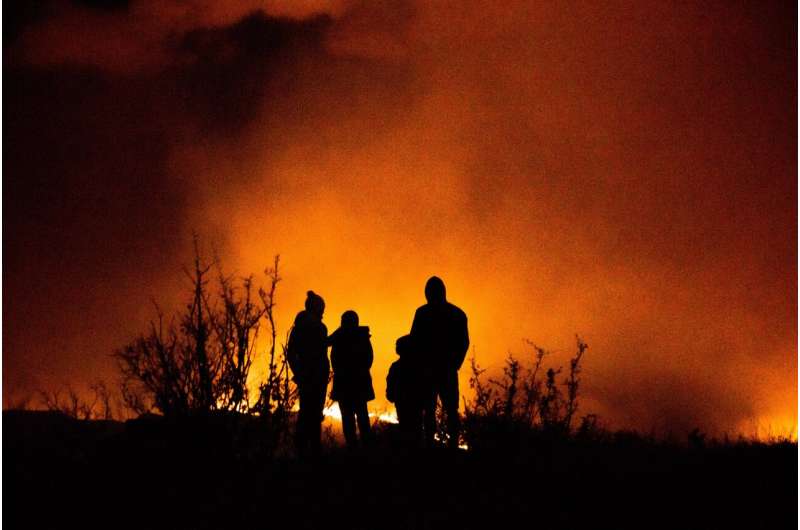This article has been reviewed according to Science X's editorial process and policies. Editors have highlighted the following attributes while ensuring the content's credibility:
fact-checked
trusted source
written by researcher(s)
proofread
The Jasper fire highlights the risks climate change poses to Canada's world heritage sites

Climate change and extreme weather events pose a real risk to the world's heritage sites—a stark reality laid bare by the recent wildfire in Jasper, Alta.
Canada has 22 United Nations Educational, Scientific and Cultural Organization (UNESCO) world heritage sites, most of which are at high risk of disruption due to climate change and their particularly vulnerable location.
The catastrophic wildfire to recently hit Jasper burned significant parts of Jasper National Park, which—along with Banff, Kootenay and Yoho—forms a part of the Canadian Rocky Mountain Parks.
While all wildfires that cause damage or loss of life are tragic, the damage to such a globally renowned site makes the Jasper wildfire unique in the context of Canadian wildfire events. Wood Buffalo National Park was affected by fire in 2023, however, that fire was not on the scale that we have seen in Jasper.
The catastrophic Jasper fire highlights the vulnerability of Canada's UNESCO World Heritage sites to the dual threat of climate change and extreme weather events, particularly wildfires.
Becoming recognized
Becoming a UNESCO world heritage site is a recognition only a few places around the world have achieved. Sites are chosen for the natural, cultural or historic values, and the program aims to protect them while providing benefits to visitors and local residents.
According to the World Heritage Convention—the world heritage site system's founding document—world heritage sites possess "priceless and irreplaceable assets, not only of each nation, but of humanity as a whole. The loss, through deterioration or disappearance of any of these most prized assets constitutes an impoverishment of the heritage of all the peoples of the world."
A world heritage site can be removed from the list or be listed as heritage in danger if the site is lost, threatened, or the country or jurisdiction that manages the site proves unable to address threats to its integrity.
The Jasper wildfire indicates that Canada may be increasingly unable to fully protect its world heritage sites from wildfire—despite decades of accumulated knowledge as to the growing problems wildfires will pose in a warming world.
For now, the town of Jasper will rebuild, but can we effectively protect the Canadian Rocky Mountain Parks, and other Canadian sites like it, in the future? Unfortunately, this seems an unlikely goal.
Under threat
Climate change threatens our planet's heritage sites in several interconnected ways.
Focusing on droughts and wildfires, we know that climate change has increased both the length and intensity of these events. Droughts also drastically change the character of the natural parks and contribute to more wildfire events—among other impacts, such as loss of biodiversity and habitat degradation.
The evidence is clear that wildfires are partially driven by droughts and that Jasper National Park is especially vulnerable.
For years, we have known that wildfires are tied to climatic conditions and that climate change will only fuel more intense and longer lasting wildfires. Studies have shown that climate conditions in Jasper National Park are changing and that the probability of large-scale fires in the Jasper National Park region will increase over time. Unfortunately, these predictions seem to be coming to pass.
Wildfires and droughts are not the only climate change-related challenges for Jasper and other national parks.
Rising temperatures due to global warming also contributes to the loss and recession of glaciers. A 2019 analysis has shown that the health of the alpine glaciers in Jasper National Park are poor. These same glaciers are specifically mentioned by UNESCO as an essential aspect of the parks world heritage status. The loss of the glaciers would be devastating for the park.
Meanwhile, the changing environmental conditions have allowed new invasive species to thrive. One species in particular, the mountain pine beetle, has become so ubiquitous throughout the region that it is likely that the swathes of dead trees left in its wake contributed to the recent Jasper wildfire.
Decades of evidence and modeling has become a tragic lived experience in Jasper. The threats to Canada's world heritage sites, and the Canadian Rocky Mountain Parks in particular, are myriad and require an entirely different approach from what has come before.
New approach needed
The Jasper fire demonstrated that existing federal and provincial level fire management strategies, focusing on prescribed burning and fire suppression, are insufficient to the task at hand.
Meanwhile, it is evident that the municipal authorities' FireSmart program was unable to effectively minimize wildfire damages with around one-third of the structures in the town destroyed by the fire.
Many of Canada's world heritage sites are at an increasing risk of wildfire in a warming world. It is essential that protecting Canada's world heritage sites from fire be a key component of any national wildfire strategy.
More generally, our efforts and resources should be directed towards how we can most effectively respond to extreme weather and fire to protect heritage sites while also mitigating the impacts of climate change on these sites.
Ultimately, protecting Canada's, and the world's, heritage sites from climate change requires both urgent action and the recognition that the loss of even just one of these sites is a tragedy for all humanity.
Provided by The Conversation
This article is republished from The Conversation under a Creative Commons license. Read the original article.![]()




















